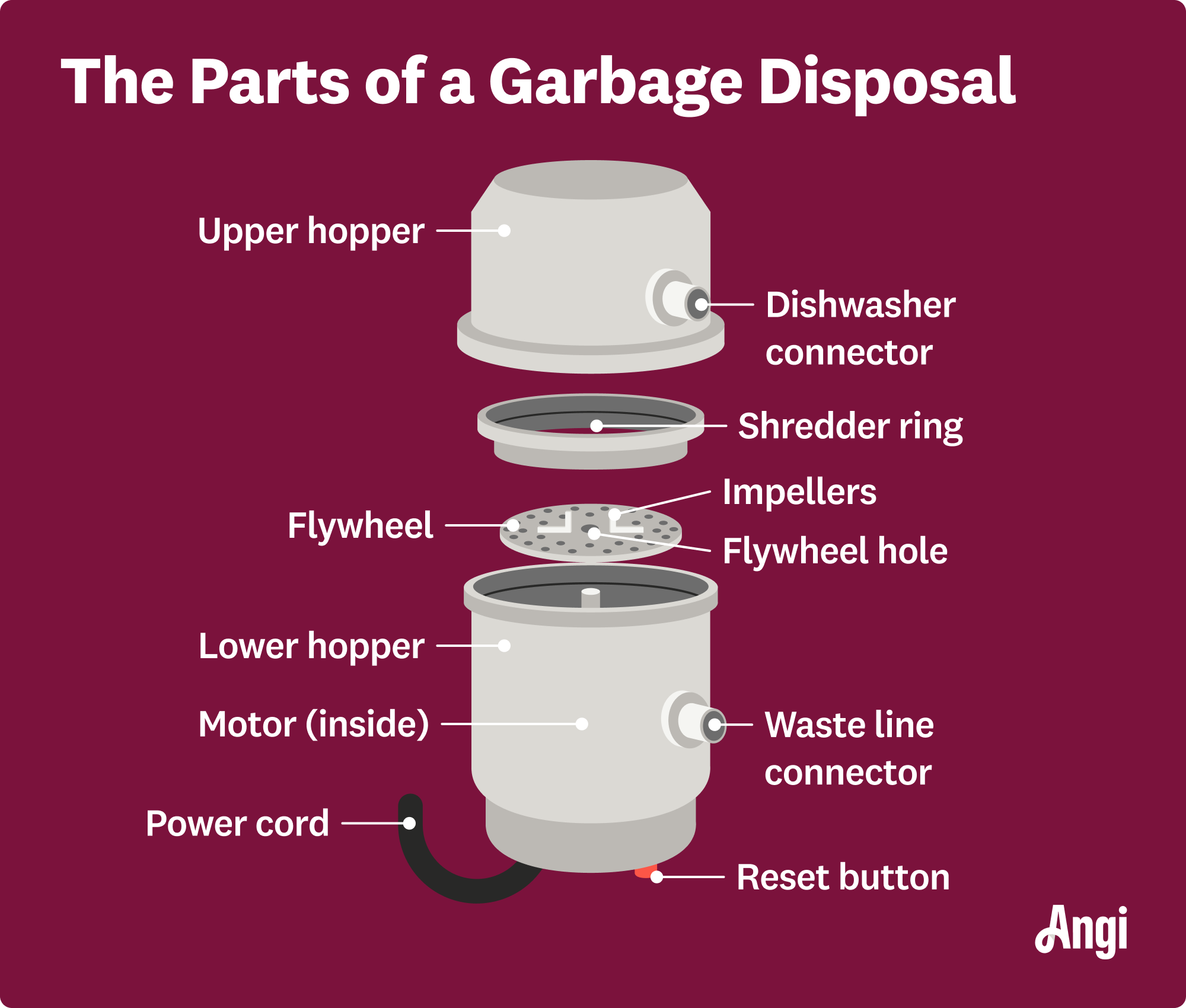
Discover the average ice maker repair cost, key price factors, and tips to save. Learn how to budget for your ice maker repair and when to repair or replace.
You can't see them, but you know they're there


Your garbage disposal uses several moving parts to break up food and prevent clogs.
Knowing how your disposal works can help you troubleshoot.
You should call a professional to install or repair a garbage disposal.
Most garbage disposal repairs average about $250.
Garbage disposals can ease your nightly meal cleanup. These handy kitchen appliances help keep food bits from clogging your sink drain. If your garbage disposal isn't working, the problem lies somewhere inside it. Knowing the parts of a garbage disposal can help you troubleshoot and keep it in good working condition.

When food falls into your kitchen sink drain, it heads into the upper chamber of the garbage disposal. Once you turn the disposal on, it goes to work, breaking down food pieces and keeping them from clogging your drain. Here's how all the parts of a garbage disposal work together to simplify your life.
The chamber of your garbage disposal holds the food waste. The top part of the chamber is the upper hopper. When you push food from the sink into the disposal, it first falls into the upper hopper. That's where it remains until you switch the disposal on.
Most modern garbage disposals have a dishwasher connector, a small nub on the side of the upper hopper. You connect the dishwasher hose to the nub, and any waste from the wash cycle travels through the hose into the upper hopper.
Here's where the fun begins. Sandwiched between the upper and lower hoppers are the parts that make garbage disposals come to life. First up is the shredder ring.
True to its name, the shredder ring shreds the food pieces. The food becomes nearly liquefied when the shredder ring does its job correctly. You definitely want to avoid coming into contact with it when it's moving.
Contrary to popular belief, garbage disposals don’t actually have blades like you’d find in blenders or food processors. Instead, they use dull hammers to grind—not chop—the food waste in your sink.
The shredder ring works in tandem with the flywheel, which spins fast, up to 2,000 RPM, pushing food against the shredder ring.
The flywheel also plays an important role in preventing food from passing into the lower hopper until it's completely pulverized. The wheel is covered in tiny holes. No food can pass through until it's small enough.
The impellers rest on top of the flywheel. While the wheel spins and pushes against the shredder ring, the impellers help to break up the food.
Some people call the impellers the "blades" of a garbage disposal, but they aren't blades at all.
You risk hurting yourself if you touch the impellers, shredder ring or flywheel. It’s best to call a local garbage disposal company if you suspect a problem with any of those components.
The lower hopper of the garbage disposal holds the motor. It's also the chamber pulverized food passes through on its way out of your sink system.
The motor powers your garbage disposal, allowing the flywheel and impeller to spin and break up the food.
All that food has to go somewhere. The waste line connector in the lower hopper connects to a drainpipe that carries food and water away from your sink.
Underneath your garbage disposal, you're likely to find a reset button. Pressing this is usually the easiest way to reset the garbage disposal, but it may not always work. If your disposal won't turn on, flip the switch to off, then press the reset button. Turn the disposal back on and see if it works.
If you hear a "click" but the unit doesn't power on, then there could be a clog somewhere along the way. There are several ways to remove a clog from a garbage disposal. Just remember never to put your bare hands inside.
The flywheel hole is also found on the underside of your garbage disposal. Simply put, it's a hexagon-shaped hole designed for use with an Allen wrench or special tool that may have come with your disposal.
In case of a jam, place the Allen wrench or tool in the hole, then turn clockwise and counterclockwise several times. The impellers and flywheel should start to spin freely. You may need to use pliers to remove any objects jamming the flywheel.
If loosening the flywheel hole or pressing the reset button doesn't fix the problem, you may have to hire a professional to repair or replace the garbage disposal.
Your garbage disposal needs electricity to operate. The power cord connects it to a nearby electrical outlet, often controlled by a light switch near your kitchen sink.
From average costs to expert advice, get all the answers you need to get your job done.

Discover the average ice maker repair cost, key price factors, and tips to save. Learn how to budget for your ice maker repair and when to repair or replace.

Get expert insights on dishwasher repair cost, including average prices, key cost factors, and tips to save money on repairs.

Get transparent refrigerator repair cost info. Learn what impacts price, compare repair vs. replacement, and find ways to save on your fridge repair.

Learning how to install a washing machine standpipe drain is not the most complicated task, but you need to follow the steps precisely to ensure nothing leaks or breaks.

Learning how to determine washer box height in your laundry room will come in handy when you need to access your washer connections.

This article outlines the top reasons why your electric cooktop may not be working and the most straightforward solutions to each problem.